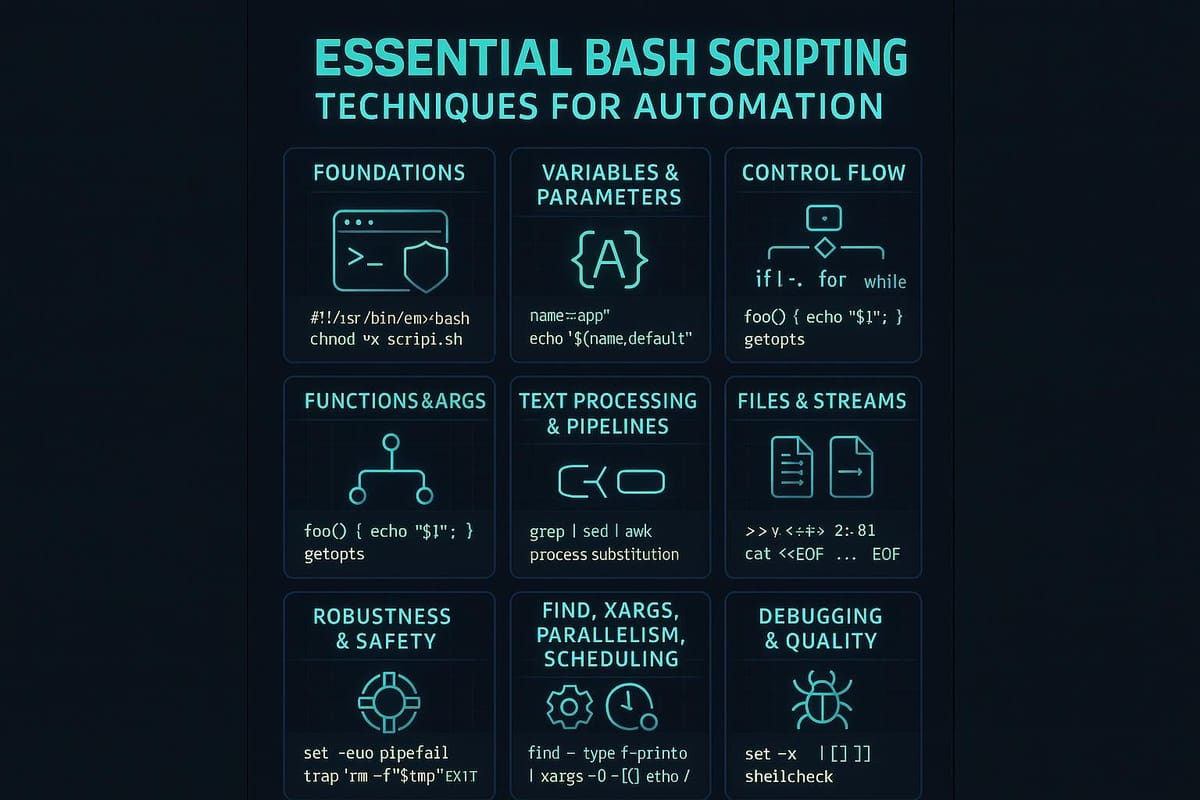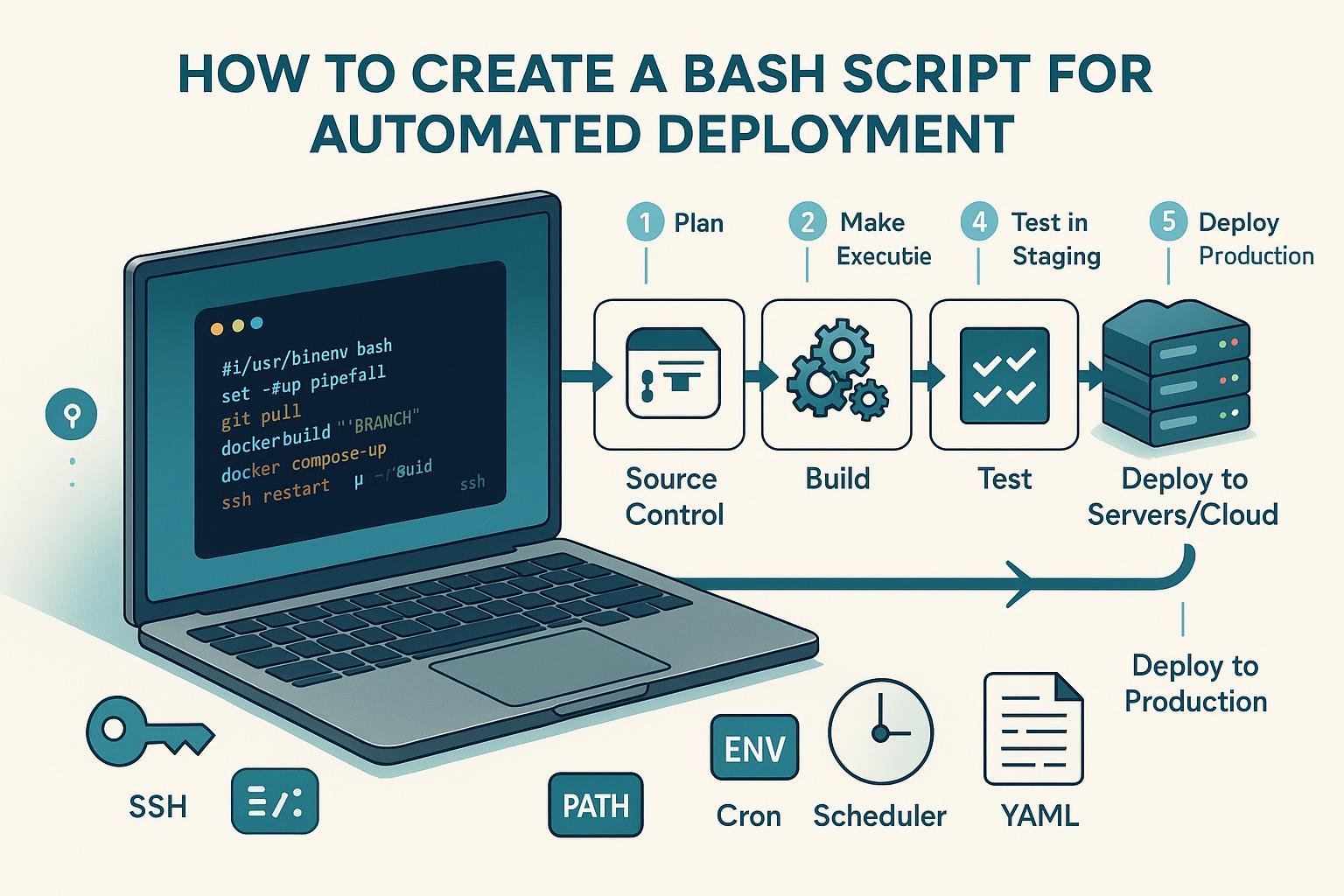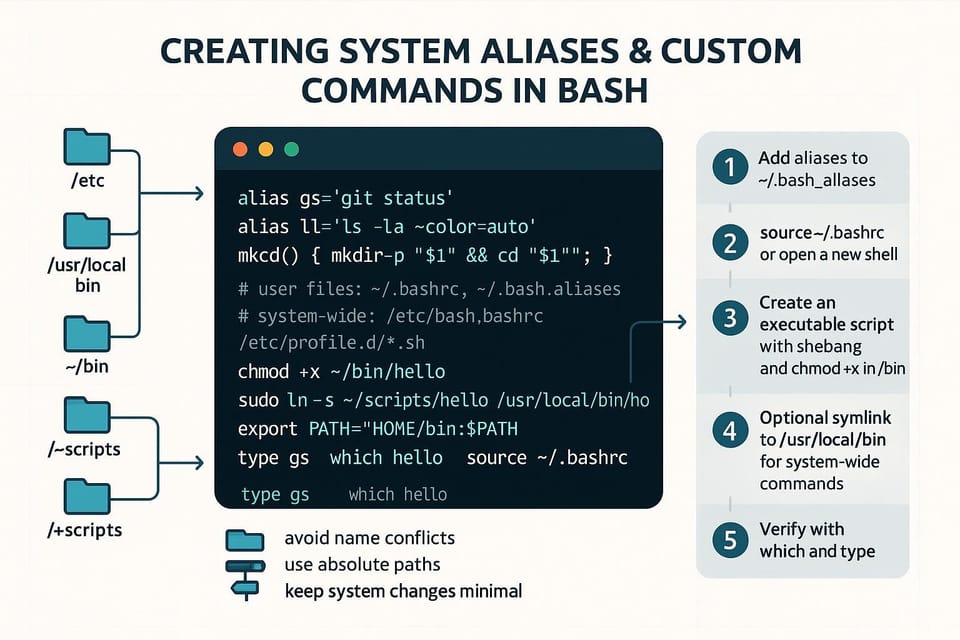Essential Bash Scripting Techniques for Automation
Learn essential Bash scripting techniques to automate tasks on Linux with clear examples and best practices. Perfect for Linux and DevOps beginners looking to boost efficiency.

Short introduction:
Bash is the glue of many automation tasks on Unix-like systems — lightweight, powerful, and available almost everywhere. This tutorial gives practical, beginner-friendly techniques you can use right away to write safer, more maintainable Bash scripts for automation.
Getting started: script skeleton, shebang, and execution
Every Bash script should start with a shebang so the kernel knows which interpreter to use. Then make the file executable and run it.
Example script (save as hello.sh):
#!/usr/bin/env bash
# Simple script that greets the user
name="${1:-World}" # positional arg or default
echo "Hello, $name!"
Make it executable and run:
chmod +x hello.sh
./hello.sh Alice
# Output: Hello, Alice!
./hello.sh
# Output: Hello, World!
Why this matters:
- Using /usr/bin/env makes your script more portable across systems.
- Always check the file permission (chmod +x) before assuming you can run the script.
- Prefer readable, short scripts and delegate heavy logic to functions (see later).
Variables, quoting, and command substitution
Variables are simple in Bash but quoting rules are crucial to avoid word splitting and globbing bugs.
Assignments and usage:
greeting="Hello"
name="Alice"
echo "$greeting, $name" # use double quotes to preserve spaces
count=$(wc -l < file.txt) # command substitution (preferred)
files=( *.txt ) # array with glob expansion
echo "Found ${#files[@]} txt files"
Quoting rules in brief:
- Double quotes ("") preserve most characters but allow variable and command substitution.
- Single quotes ('') prevent substitutions entirely.
- Unquoted variable expansions can split into multiple words or be interpreted as globs — usually undesirable.
Safe default for undefined variables:
set -u # treat unset variables as an error
name="${1:-default}" # provide fallback to avoid errors
Control flow, loops, and functions
Control structures let you express logic cleanly. Break repeated behavior into functions.
If/elif/else:
if [[ -f "$1" ]]; then
echo "$1 exists and is a file"
elif [[ -d "$1" ]]; then
echo "$1 exists and is a directory"
else
echo "$1 does not exist"
fi
Loops:
# For each file passed as args
for f in "$@"; do
echo "Processing: $f"
done
# Read lines safely (handles spaces)
while IFS= read -r line; do
echo "Line: $line"
done < input.txt
Functions and exit codes:
log() { printf '%s\n' "$*"; }
backup_file() {
local src="$1" dst="$2"
cp -- "$src" "$dst" || return 1 # return non-zero on failure
log "Backed up $src to $dst"
}
if backup_file "a.conf" "a.conf.bak"; then
log "Success"
else
log "Backup failed"
fi
Tips:
- Use local variables inside functions: local foo=...
- Rely on exit codes and use || and && to control flow concisely.
Essential commands (commands table)
Below is a handy table of commonly used Bash/Unix commands for automation, with quick examples.
| Command | What it does | Example |
|---|---|---|
| grep | Search text using patterns | grep -i "error" logfile |
| awk | Field processing and reporting | awk -F: '{print $1}' /etc/passwd |
| sed | Stream editing (substitute) | sed 's/foo/bar/g' file |
| xargs | Build and run commands from stdin | find . -name '*.tmp' |
| find | Find files recursively | find /var/log -name '*.log' -mtime +7 |
| tee | Write stdout to file and stdout | somecmd |
| jq | Parse JSON (if installed) | curl ... |
| cut | Extract columns | cut -d',' -f2 file.csv |
Examples that combine commands:
# Delete .tmp files older than 7 days (preview first)
find . -name '*.tmp' -mtime +7 -print # preview
find . -name '*.tmp' -mtime +7 -print0 | xargs -0 rm -v
Why use these:
- Pipes and small tools let you build powerful one-liners and readable scripts.
- Prefer composability: one tool per job (grep to filter, awk to transform, sed to edit).
Automation patterns and safe scripting
When automating, safety and observability matter: use strict settings, logging, argument parsing, and scheduled jobs.
Shell safety flags:
#!/usr/bin/env bash
set -euo pipefail
IFS=$'\n\t' # safer default IFS
- set -e: exit on first command that fails (be careful with commands that return non-zero on purpose).
- set -u: error on unset variables.
- set -o pipefail: return non-zero if any command in a pipeline fails.
Argument parsing with getopts:
usage() { echo "Usage: $0 -s source -d dest"; exit 2; }
while getopts ":s:d:h" opt; do
case "$opt" in
s) src="$OPTARG" ;;
d) dst="$OPTARG" ;;
h) usage ;;
*) usage ;;
esac
done
shift $((OPTIND-1))
[ -n "${src:-}" ] || usage
[ -n "${dst:-}" ] || usage
Cron scheduling:
- Edit crontab: crontab -e
- Always redirect stdout and stderr to a log file for scheduled jobs.
- Test the script manually before scheduling it.
Example cron entry (runs at 2:30am daily):
30 2 * * * /usr/local/bin/backup.sh >> /var/log/backup.log 2>&1
Tips:
Cleanup with trap:
tmpdir=$(mktemp -d)
trap 'rm -rf "$tmpdir"' EXIT ERR INT TERM
# do work using $tmpdir
trap ensures temporary resources are cleaned on exit or interruption.
Logging patterns:
log() { printf '%s %s\n' "$(date --iso-8601=seconds)" "$*"; }
log "Starting job"
Consistent timestamps and messages make debugging scheduled tasks much easier.
Common Pitfalls
- Unquoted variable expansion: echo $files can break on filenames with spaces; prefer "$files" or iterate arrays.
- Relying only on set -e: some commands in pipelines or conditional checks can mask failures; combine with pipefail and explicit checks.
- Not testing scripts interactively: always run scripts manually with sample inputs, and add verbose/debug mode (e.g., -x) before putting them into cron.
Next Steps
- Practice: write small scripts to automate daily repetitive tasks (backups, log rotation, report generation).
- Learn one tool deeply: choose awk or sed and solve a few text-processing problems with it.
- Version and test: put scripts in Git, add comments and usage output, and test them on edge cases (empty inputs, missing files).
This guide covers the essentials needed to start scripting efficiently and safely in Bash. Use small, composable tools, prefer clear error handling, and iterate — your automation will become more reliable and easier to maintain as you apply these techniques.
👉 Explore more IT books and guides at dargslan.com.




